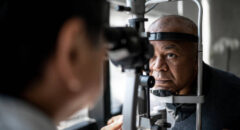
Black Americans are at higher risk for eye diseases like diabetic macular edema, diabetic retinopathy and glaucoma, which can lead to vision loss and blindness unless detected early.
To help increase eye health awareness and promote early detection of eye disease, the National Eye Institute (NEI) and its National Eye Health Education Program (NEHEP) have launched Write the Vision: Make Your Plan to Protect Your Sight.
This new initiative is developed specifically for Black Americans and offers tips like the following to help protect your sight.
1. Get a comprehensive dilated eye exam.
Because many eye diseases have no warning signs or symptoms, early detection is important for preventing vision loss and blindness. Black Americans age 40 or older should have a comprehensive dilated eye exam as part of their regular healthcare routine, as directed by their eye care professional.
2. Learn your family’s eye health history.
We don’t just inherit the shape or color of our eyes from our parents.
We inherit their eye health, too. And, especially for Black Americans, your family tree can put you at risk for glaucoma.
Knowing if you are at risk for eye disease can help save your sight.
3. Don’t get blindsided by diabetic eye disease.
People with diabetes are at risk for diabetic eye disease, which often has no symptoms in its early stages.
Black Americans are at higher risk for the disease, which, if left undetected, can cause vision loss and even blindness.
Keep your diabetes under control and get a comprehensive dilated eye exam at least once a year to help protect your sight.
4. Be cool and wear your shades.
Sunglasses are a great fashion accessory, but their most important job is to protect your eyes from the sun’s ultraviolet rays.
When purchasing sunglasses, look for ones that block out 99 to 100 percent of both UV-A and UV-B radiation.
5. Learn more about your vision.
Our eyesight changes as we age. Some changes can be corrected with eyeglasses or better lighting.
Other changes may signal more serious threats to your vision.
There’s an easy way to know for sure: See your eye care professional.

Improving Blurry Vision
Blurry vision is a common symptom of diabetic eye disease, which includes conditions like diabetic retinopathy and diabetic macular edema. Managing your vision health is crucial to prevent permanent damage. Here are five effective ways to improve blurry vision and a guide on when to seek medical help.
1. Maintain Consistent Blood Sugar Levels
Fluctuating blood sugar can cause the lens of your eye to swell, leading to blurred vision. To help:
- Monitor blood glucose regularly.
- Follow your doctor’s dietary and medication advice.
- Aim for a stable A1C level (typically under 7%, depending on your doctor’s recommendation).
2. Follow a Diabetic-Friendly Diet
Nutrition plays a key role in eye health. Focus on:
- Low-glycemic foods to avoid sugar spikes.
- Foods rich in vitamins A, C, and E, and omega-3 fatty acids.
- Staying hydrated supports eye function.
3. Exercise Regularly
Physical activity helps regulate blood sugar and improve circulation, including to the eyes. Try:
- Brisk walking, swimming, or yoga.
- At least 150 minutes of moderate exercise weekly.
4. Use Prescribed Eye Medications or Injections
If you’ve been diagnosed with diabetic macular edema or diabetic retinopathy:
- Your doctor may prescribe anti-VEGF injections (e.g., Avastin, Eylea, Lucentis) to reduce swelling and prevent vision loss.
- Corticosteroid injections may also help reduce inflammation.
5. Undergo Regular Eye Exams and Treatments
Early detection is key to preserving sight. Depending on the condition’s severity, your ophthalmologist might recommend:
- Laser treatments (photocoagulation) to stop blood vessel leakage.
- Vitrectomy surgery if there’s bleeding in the eye or retinal detachment.
When to See a Doctor
Contact an eye specialist immediately if you notice:
- Sudden or severe changes in vision
- Dark spots or floaters that increase in number
- Difficulty seeing at night
- Straight lines appearing wavy
- Eye pain or pressure
Regular check-ups (at least once a year) with an ophthalmologist are essential, even if your vision seems fine. Diabetic eye disease can progress silently.









